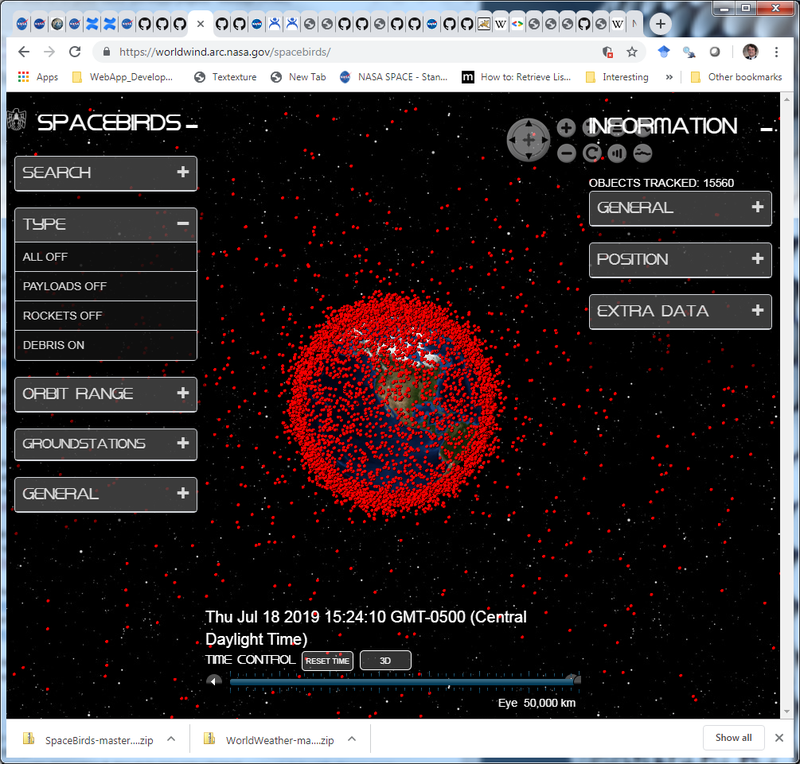The Challenge
Background
Nuts, bolts, spent rocket stages, and broken pieces of satellites orbiting Earth are just a few of the many thousands of items known as orbital debris or space junk. Traveling at many different speeds, but up to about 17,000 miles per hour, space junk poses a threat to satellites and space stations. Figure 1 presents a screenshot of NASA’s Spacebirds web-app that depicts more than 15,500 pieces orbital debris speeding around the Earth, but some estimates put the number at over 23,000 pieces.

Figure 1 Spacebirds web-app presenting orbital debris
Our skies provide humanity with access to space, and as such, the space closely surrounding the Earth is a natural resource to be preserved. Your challenge is to design and/or develop a video game web-app that can educate the public about the problem of orbital debris and inspire people to think about how to capture and dispose of it — and maybe even profit from it by selling the debris as scrap!
Potential Considerations
In pursuing this challenge, consider how different points-of-view can be used in your game; your point-of-view could be first-person, third-person, or both. Here we provide examples of what types of products you could create, but you can create whatever type of solution you prefer. The sky’s the limit!
Beginner-level teams with limited programming skills could focus on the design of the video game. A video game design could focus on an interactive webpage that displays 2D images of the video game screen design with scores. A simple 2D design could depict the Earth with objects around it and a keyboard-operated spacecraft. Examples of beginner-level solutions could include (but are not limited to):
- a video presentation about the video game design;
- conceptual video screen designs and/or flowcharts for interactions among the keyboard, spacecraft, space objects, and scoring display;
- a 2D interactive webpage that demonstrates player actions, such as using a spacecraft to capture an object and increase the player’s score; or
- a 2D videogame web-app that depicts the Earth surrounded by debris and a third-person view of a keyboard-operated spacecraft capturing objects to increase the player’s score.
Intermediate-level teams with some knowledge of 3D computer graphics could use a JavaScript code library to produce a web-app that includes a texture-mapped sphere to represent the Earth surrounded by objects that represent orbital debris. As a keyboard-operated spacecraft model captures the objects, the objects would disappear from the screen and increase the score. Examples of intermediate level solutions could include (but are not limited to):
- a video presentation that demonstrates a 3D video game;
- a deployed 3D video game web-app with an Earth view or a first- or third-person view of a keyboard- or joystick-operated spacecraft, and space debris objects; or
- in a more advanced version, the space debris objects could be animated and move around the Earth, and the parametric circle equation could produce time-stepped coordinates. An even more advanced version could simulate elliptical orbits.
Advanced-level teams can build upon the Spacebirds code base and the NASA Web WorldWind 3D globe open source library to develop a video game web-app that is based upon real-world data. The resources section will provide links to the Spacebirds Github repository, Web WorldWind tutorials, and Application Programming Interface (API) documentation. Modifications to the Spacebirds code could revise the user interface to show only the space debris or a subset of the space debris in order to increase performance. Examples of advanced-level solutions could include (but are not limited to):
- a video presentation that demonstrates a deployed video game web-app and explains how the Spacebirds code base was used in the development;
- a deployed video game web-app with a first- or third-person view of a keyboard- or joystick-controlled spacecraft that captures orbital debris. A more advanced version of the game could include variables such as propellant level as well as the score.
Example Resources
Search keywords for beginning video game development include:
- Developing video games from scratch
- Beginner tutorials for web video game development
- Beginning video game web app development
Find simple examples of 2D video game web-apps and associated tutorials.
Search keywords for intermediate 3D video game web app development include:
- 3D javascript code library
- webgl code library
- webvr library
Find code libraries that enable the development of interactive 3D web-apps. Search for tutorials and examples that can be used as a starting point for development.
Keywords to understand how to read orbital bodies’ TLEs in terms of latitude, longitude and altitude in a web application include:
- TLE JavaScript
- Propagation of satellite TLE in JavaScript
NASA in no way endorses any non-U.S. Government entity and is not responsible for information contained on non-U.S. Government websites.